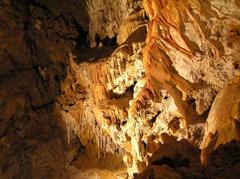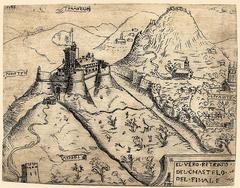Castrum Perticae: Visiting Hours, Tickets, and Travel Guide to Finale Ligure’s Historic Fortress
Date: 14/06/2025
Introduction: Why Visit Castrum Perticae?
Perched atop the scenic Rocca Carpanea above Finale Ligure, Castrum Perticae is a captivating site that weaves together Liguria’s prehistoric, Byzantine, and medieval heritage. This fortress offers archaeological intrigue, panoramic coastal views, and a unique immersion into the region’s layered history. Whether you’re passionate about history, hiking, or landscape photography, Castrum Perticae invites you to discover centuries of human settlement within the lush Mediterranean maquis (viaggi.corriere.it; pleiades.stoa.org).
Table of Contents
- Origins and Early Settlement
- Byzantine Foundation and Defensive Role
- Architectural Features and Archaeological Remains
- Medieval Transformation: The Church of San Antonino
- Practical Visitor Information
- Archaeological and Cultural Significance
- Architectural and Archaeological Features
- Frequently Asked Questions (FAQs)
- Conclusion and Call to Action
- References
Origins and Early Settlement
Castrum Perticae’s location has attracted human settlement since the Late Bronze Age. Archaeological evidence reveals the presence of prehistoric hilltop settlements (castellari), dolmens, and menhirs throughout the Finale region (viaggi.corriere.it). These early communities chose elevated terrain for defensive purposes, laying the foundation for later fortifications.
Byzantine Foundation and Defensive Role
Established in the 6th century CE, Castrum Perticae became a critical node in the Byzantine defensive network against Lombard invasions and Saracen raids. Its strategic placement, 475 meters above sea level on Rocca Carpanea, provided surveillance over the valleys and Ligurian Sea, allowing communication with neighboring strongholds like Castel Gavone (pleiades.stoa.org; finalehiking.it).
Architectural Features and Archaeological Remains
The fortress remains feature:
- Limestone ramparts: Defensive walls that once shielded the settlement.
- Watchtower and gate foundations: Indicating points of control and observation.
- Integration with natural formations: The rocky landscape and karst features, including “Frati” cliffs popular with climbers, provided natural defense (finalehiking.it).
Archaeological digs have unearthed Byzantine coins, ceramics, and structural remnants, now displayed at the Museo Archeologico di Finalborgo (YouReporter).
Medieval Transformation: The Church of San Antonino
In the 12th century, the Romanesque Church of San Antonino was constructed atop the fortress ruins (finalehiking.it). Key features include:
- Romanesque Apse and Thick Stone Walls: Hallmarks of medieval ecclesiastical architecture.
- Crypt and Oracular Cave: Accessible via a tunnel, the crypt is linked to ancient spiritual practices and legends of oracles (gulliver.it). Bring a flashlight for safe exploration.
- Panoramic Views: The church offers breathtaking vistas of the Ligurian hinterland.
Practical Visitor Information
Visiting Hours & Best Times
- Castrum Perticae: Open year-round from dawn to dusk; best visited in spring and autumn for mild weather.
- Church of San Antonino: May have restricted or seasonal hours—confirm with local tourism offices (Comune di Finale Ligure).
Entry & Tickets
- Fortress Ruins: Free entry.
- Guided Tours: May incur a fee; offered by local organizations and the Istituto Internazionale di Studi Liguri. Advance booking is recommended.
Accessibility
- The archaeological area is reached via moderate hiking trails with uneven terrain. Not suitable for wheelchairs or those with significant mobility issues.
- Wear sturdy shoes, bring water, and plan for a hike of about 20–30 minutes from the nearest parking.
Getting There
- By Car: Park in Casevalle near Perti; follow marked trails.
- Public Transport: Finale Ligure is well-connected by train and bus; reach trailheads by foot or local taxi.
- Coordinates: 44° 11’ 40” N, 08° 19’ 21” E
Facilities
- No restrooms or food services onsite—carry essentials.
- Nearby villages (Perti, Finalborgo) offer amenities.
Nearby Attractions
- Castel Gavone
- Finalborgo medieval village
- Prehistoric caves such as Arma delle Arene Candide
Archaeological and Cultural Significance
Prehistoric and Protohistoric Context
The Finale area is rich with prehistoric caves and rock engravings, including significant finds like the “Young Prince” burial. These discoveries illuminate the complex spiritual and social life of early Ligurian cultures (Liguria Italia Guida; Outdooractive).
Roman and Early Medieval Heritage
While Castrum Perticae is primarily medieval, its foundations and surroundings reveal traces of Roman roads and early Christian settlements. Inscriptions dating to 517 CE indicate long-term habitation and Christian influence.
Medieval Fortifications and Artistic Features
The castrum is part of a network of fortified medieval settlements, featuring robust stonework and Romanesque elements. The black-and-white striped facades of churches in Finale Ligure are characteristic of the region.
The Museo Diffuso del Finale
Castrum Perticae is integrated into the open-air “Museo Diffuso del Finale,” which connects archaeological sites, trails, and interpretive panels across the landscape, enriching the visitor experience (Outdooractive).
Ritual and Symbolic Layers
The area’s prehistoric rock engravings and the crypt below San Antonino reflect the enduring sacredness of the site, evolving from pagan ritual to Christian worship.
Local Traditions and Events
Castrum Perticae remains woven into local identity. Cultural festivals, guided hikes, and climbing events are organized throughout the year, blending heritage preservation with outdoor adventure (Outdooractive).
Architectural and Archaeological Features
Fortifications
- Walls: Western and northern ramparts capitalize on natural cliffs.
- Interior: Foundations of dwellings and communal spaces.
Church of Sant’Antonino
- Single nave with trapezoidal plan
- Crypt and tunnel: Former pagan site, later Christianized.
- Restored after 1887 earthquake: The crypt and mysterious cave remain accessible to visitors (YouReporter).
Museum Connection
Artifacts from the site are housed at the Museo Archeologico di Finalborgo, offering deeper insight into local history.
Frequently Asked Questions (FAQs)
Q: What are Castrum Perticae’s visiting hours?
A: The site is open year-round from dawn to dusk. The church may have seasonal hours—check with Comune di Finale Ligure.
Q: Do I need a ticket?
A: Entry to the archaeological area is free. Fees may apply for guided tours.
Q: Is Castrum Perticae accessible for people with disabilities?
A: The rugged trails and uneven terrain make access challenging for those with limited mobility.
Q: How do I get there?
A: Drive or use public transport to Finale Ligure, park near Perti, and follow marked trails for about 20–30 minutes.
Q: Are guided tours available?
A: Yes, advance booking is recommended. Tours can be arranged through local organizations or the Società Guide Alpine Finale.
Conclusion and Call to Action
Castrum Perticae is a must-see for anyone interested in Liguria’s history, hiking, and natural landscapes. The fortress and its Romanesque church transport visitors through millennia of regional transformation, while the panoramic setting and integration with the “Museo Diffuso del Finale” provide a well-rounded, immersive experience.
Plan your visit:
- Check current opening hours and events via the Comune di Finale Ligure tourism portal.
- Book a guided tour for expert insights.
- Download the Audiala app for interactive maps, audio guides, and up-to-date travel tips.
- Combine your visit with nearby attractions and enjoy local cuisine in Finalborgo or Perti.
Explore, discover, and connect with the living heritage of Finale Ligure—Castrum Perticae awaits!
References
- viaggi.corriere.it
- pleiades.stoa.org
- finalehiking.it
- gulliver.it
- Outdooractive
- liguria.italiaguida.it
- Comune di Finale Ligure
- YouReporter
- Gulliver
- Visit Finale Ligure
- Wandering Italy
For more travel inspiration, guides, and updates, follow us on social media and download the Audiala app.

